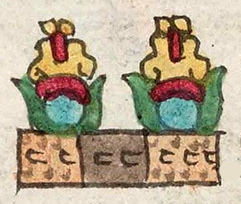Xochimilco (Mdz2v)
This compound sign for the place name Xochimilco has to elements for interpretation. One is the pair of flowers, sitting upright. The other is the horizontal, cultivated land parcel, the milli. The flowers are multicolored (red, yellow, turquoise blue, and green) and detailed in a way that one could possibly identify the parts (the sepals, ovaries, styles, stigmas, etc.). The land parcel is segmented and textured, probably with symbols showing that it is cultivated. Two of the segments are a light terracotta color, and one is purple. The texturing consists of dots and tipped-over U shapes. The locative suffix -co is not shown visually, but perhaps the landscape provides a semantic locative.
Stephanie Wood
Glyphs for flowers are often highly detailed and colorful. The attention to detail and color attest to the high value placed on flowers. The two small circles at the top of this flower, the leaves, and the roots are all hallmarks that will recur with some frequency, but, naturally, this element can also be abbreviated in some compound glyphs (e.g. the example, below, from 23 recto), and it will absorb European depictions of flowers (emphasizing stem, leaves, and largely round flowers) over time. Prior to contact, flowers appeared on temples and palaces, they were cultivated in gardens (showing horticultural expertise), they were associated with a ritualized warfare, worn as necklaces and garlands, and, for these reasons and more, they were the subject of poetry. Mexicolore has a short article about the Nahuas' fondness for flowers.
Stephanie Wood
Stephanie Wood
c. 1541, or by 1553 at the latest
Stephanie Wood
nombres de lugares

Codex Mendoza, folio 2 verso, https://digital.bodleian.ox.ac.uk/objects/2fea788e-2aa2-4f08-b6d9-648c00..., image 15 of 188.
The Bodleian Libraries, University of Oxford, hold the original manuscript, the MS. Arch. Selden. A. 1. This image is published here under the UK Creative Commons, “Attribution-NonCommercial-ShareAlike 3.0 License” (CC-BY-NC-SA 3.0).







